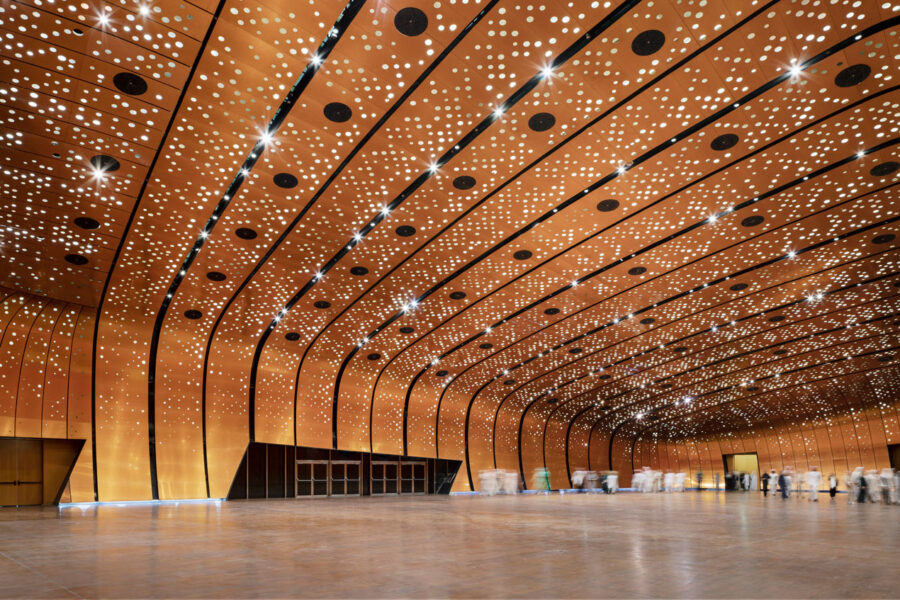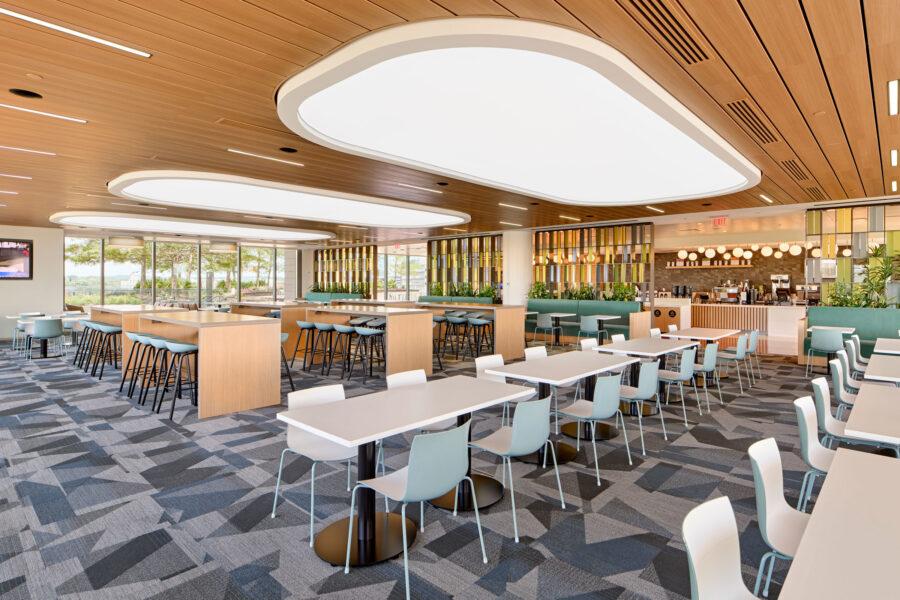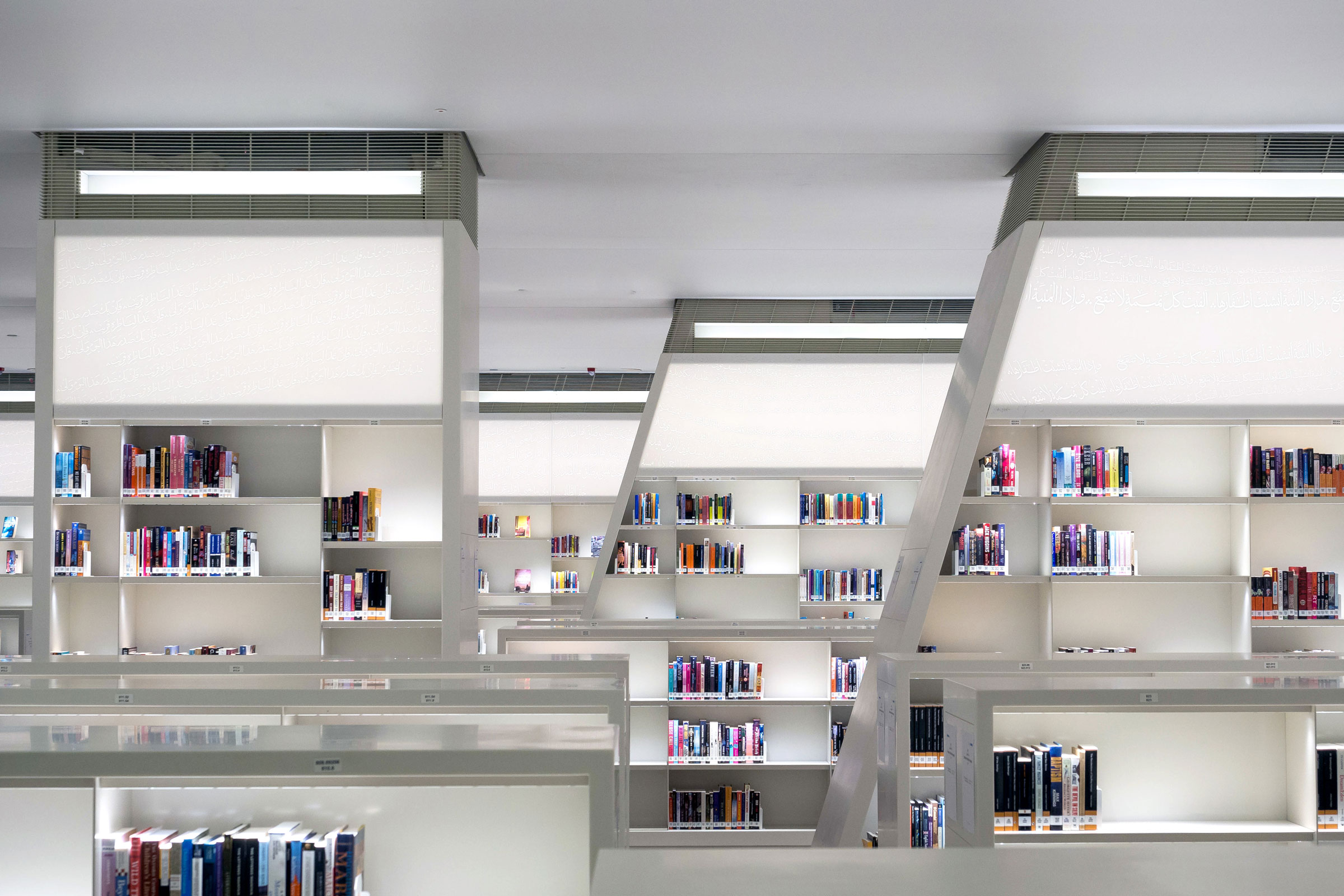Story at a glance:
- Acoustic lighting integrates illumination, acoustic performance, and aesthetics in one cohesive design.
- The benefits of acoustic lighting include improved aesthetics, performance, and, in some cases, cost savings.
- The technology aligns with a growing trend toward designing public spaces and offices for wellness.
Walking into the King Abdulaziz Center for World Culture exhibition hall in Saudi Arabia is more like being outside on a starry night—if the sky were made of copper. The lustrous paneling rises organically from the room’s edges to a crest of 13 meters, studded with thousands of tiny holes that let light gleam through.
The panels envelop a vast, open room that features world-class exhibitions like Leonardo da Vinci’s manuscripts and Edvard Munch’s paintings. However, designing the space posed a particular challenge for Snøhetta, a global architectural firm based in Norway.
While other buildings in the center include structural elements like stairs and balconies, the exhibition hall is bare, and its surfaces are hard and smooth. Without acoustic insulation, voices would reverberate around the hall as echoes, causing an unpleasant auditory experience.
To ensure the hall’s acoustic aesthetics matched its stunning visuals, Snøhetta concealed lighting and sound-absorbing insulation materials behind the copper panels. The innovation was an early example of acoustic lighting, a growing trend in the design industry that integrates illumination, acoustic performance, and aesthetics in one cohesive design.
Designing Spaces for Wellness

Lustrous paneling inside the King Abdulaziz Center for World Culture, designed by Snøhetta, rises organically from the room’s edges to a crest of 13 meters, studded with thousands of tiny holes that let light gleam through. Photo by Ivan Brodey
Traditionally designers and engineers purchased acoustic panels and lighting fixtures separately, hiding acoustics behind ceiling tiles and wall partitions. But as more buildings embrace open floor plans, the mixture of acoustic baffles and lighting fixtures in ceilings can look mismatched and cluttered.
In other cases designers compromise lighting quality or acoustic performance. The result is unhappy occupants. “We’re trending toward open landscapes, and with that comes a lot more sound and noise,” says Bjørg Aabø, a senior interior architect at Snøhetta who worked on the King Abdulaziz Center project. “So we need different means to reduce the noise impact.”
If you look at studies of complaints about offices and public spaces, lighting and noise are usually in the top five, if not the top three.
As the trend takes off, Canadian company Cooledge Lighting has unveiled a line of acoustic lighting solutions that combines lighting and acoustic performance in the same product. The company sees huge potential in deploying the technology in open offices and other large spaces.
“If you look at studies of complaints about offices and public spaces, lighting and noise are usually in the top five, if not the top three,” says Grant Harlow, the company’s vice president of marketing and communications.
The need for solutions that address poor lighting and noise control issues has grown post-pandemic, especially for companies seeking to attract workers back to the office. The design industry is increasingly focused on designing public spaces and offices for wellness.
Acoustic lighting reduces ambient noise, allowing small groups of people to hear each other more clearly and feel like their conversations are more private even in a large open space. Meanwhile, the space is well-lit and the overall visual aesthetic remains bright and modern.
A Clean Fix for Spaces Large and Small

600 Washington in Stamford was designed by Tantillo Architecture. This amenity space features three luminous elements that combine architectural form with the natural feeling of being bathed in light. Photo by Jeffrey Totaro
Harlow says the shift toward wellness means lighting and noise control designs are ripe for new approaches and technologies. Cooledge’s large-scale acoustic lighting luminaires and stretch ceilings incorporate a clean design with plenty of lighting surface area to absorb sound. The technology is a step up from acoustic lighting products that simply wrap pendants in felt or other sound-absorbing materials. While these solutions may work for small dining rooms or offices, they won’t do much in a large, noisy space.
But that doesn’t mean designers should shy away from using more robust acoustic lighting solutions in smaller spaces. Aabø says Snøhetta recently incorporated another acoustic lighting project to redesign the Oslo Opera House’s tiny gift shop. They strove to maintain the visual language they’d used in the overall building design, opting for a sound-absorbing stretch ceiling used in other spaces, but this time with a back-lit function. The effect is bright but tranquil. “It’s not a big shop,” she says. “But it’s an excellent way of keeping the noise down while taking care of the lighting and making the little space feel more intimate.”
To set the stage for optimal sound performance in any space, Harlow says designers should pay attention to sabin values, which evaluate a luminaire’s sound absorption (measured by its noise reduction coefficient, or NRC) against its size. To explain the value of sabin, he likes to use the analogy of paper towels. “No matter how good your paper towel is, you can only soak up so much water with one,” he says. “If you have a whole roll of paper towels, you can soak up much more.”
In other words, designers and engineers should account for the total surface area of acoustic lighting rather than individual fixtures’ NRC value. In most cases they should also aim to target acoustic frequencies in the range of human speech—about 100Hz to 4000Hz.
The benefits of acoustic lighting go beyond aesthetics and performance. In many cases the technology can also yield cost savings. After all, buying one product that does two things eliminates the need to buy two separate products.
Aabø agrees. “When the design has more than one function, it’s always a great thing.”

